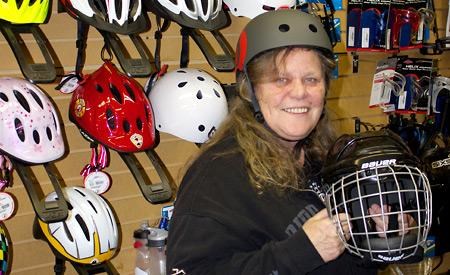Preventable head injury is the leading cause of death among young people, says a national helmet safety advocate.
Richard Kinar is a past member of the Brain Injury Association of Canada board, which works to educate the public about the dangers of brain injury and advocate preventive initiatives and programs. As a former professional skier he has helped Canadian Standards Association’s (CSA) design for a multi-impact alpine helmet and pushed the federal government to adopt tougher standards for sport helmets.
Not all helmets provide the same level of protection, said Kinar.
The federal government does not require bicycle, skateboarding and alpine sports helmets sold in Canada to meet any standards for safety or test them before they are imported, he said. “They are voluntary standards and it’s an unregulated market.”
Better helmet standards and more effective injury prevention programs could save much of the $17 to $20 billion Canada’s health care system spends annually on treating preventable head injuries, he said.
Powell River Brain Injury Society executive director and City of Powell River councillor Debbie Dee said she is taking the issue to the next committee of the whole meeting (Thursday, March 20) with the hopes that council will back a national resolution at this spring’s Federation of Canadian Municipalities’ annual conference in Ontario.
Municipal governments have been expressing concerns about the issue. They would like to be able to reference some kind of international or national standard for helmets used in skateboard parks, public facilities and on municipal streets, said Dee.
Skateboarders at Powell River’s skateboard park are currently required to wear “protective gear” while using the facilities. With the park set to expand, city council is eager to clarify which safety equipment is acceptable.
Dee said the city is working on “making the park safer” for skateboarders and helmets will be mandatory.
She added that the federation passed a resolution to lobby the federal government on the issue in 2008. That year Dr. Hedy Fry, member of parliament for the riding of Vancouver Centre, put forward a bill that would regulate alpine helmets being imported to Canada, but like many private member’s bills, it was not enacted.
The problem surrounding helmet safety in Canada is that consumers can be easily misled, said Kinar. Bicycle and sport helmets sold in Canada frequently have standards stickers inside them for organizations like CE, a European standard, ASTM (American Society for Testing and Materials) or CPSC (Consumer Product Safety Commission).
Kinar said it is a case of buyer beware. “The data proves it is better to be wearing one than not,” he added. “People are buying them for protection, but the bottom line is when they are imported into Canada, the certification mark means nothing.”
In BC, cyclists are required by the Motor Vehicle Act to wear helmets that are recognized by “a national or international standard.”
John Weston, MP for West Vancouver-Sunshine Coast-Sea to Sky Country, said specific helmet regulations are up to the provincial and territorial governments to regulate.
The Peak requested comments from both the ministry of justice and attorney general and the ministry of health on the issue, but did not hear back from either before press time.
“It’s a strange paradox where we talk about needing safety equipment, but we’re not willing to regulate it,” said Kinar.
When people go to buy a helmet the government should make sure all consumers have to do is pick one that meets the personal preferences of colour, size and style—just like hockey helmets, he said. “We all know that those helmets meet a crash test standard.”
Since the 1970s hockey helmets, imported to Canada or manufactured here, have had to meet CSA standards and pass impact, penetration and roll-off tests.
They are the only kind of helmet that the federal government has placed under the jurisdiction of the Hazardous Products Act (HPA), now the Consumer Product Safety Act.
“Canadians can be reasonably confident that all hockey helmets on sale are sufficiently robust to meet the rigours of the game,” wrote lawyer Andrew Morrison and legal scholar Kernaghan Webb in their 2004 publication “Voluntary Codes: Private Governance, the Public Interest and Innovation.”
They explain that bike and other sport helmets have been treated differently, not because there have been fewer or less severe injuries, but because in the 1970s the federal government may have been more willing to impose regulations and amateur hockey pushed for them.
In 1991, the federal department of consumer and corporate affairs, under Prime Minister Brian Mulroney, looked at regulating the sale of bike helmets through the HPA and using a recently developed CSA standard, like there was with hockey helmets, but decided instead to monitor industry’s compliance with voluntary standards and consider regulation at a later point if the public decided it was necessary.
There hasn’t been a manufacturer in over 15 years that has decided to use the CSA’s standard for bike helmets, said Kinar, and now the standards organization is wondering whether to renew or scrap it.
Morrison and Webb state that the voluntary standards have successfully ensured that bicycle helmets are safe and American testing on helmets has shown that helmets sold there meet acceptable standards. However, Kinar remains unconvinced.
He would like to see the federal government step up and regulate the safety of helmets by choosing and enforcing a standard so that consumers know that the helmets “have gone through rigorous testing.”
Weston said the federal government has committed to collaborate with injury prevention organizations to reduce the injury rate in Canada such as spending $5 million in the Active and Safe initiative which promotes the safety of children and youth in high-participation sport and recreation activities.
“Kids have a legitimate recreational opportunity in these parks and there’s a good reason for them to be there,” said Kinar, “but let’s make it as safe for them as possible.”



